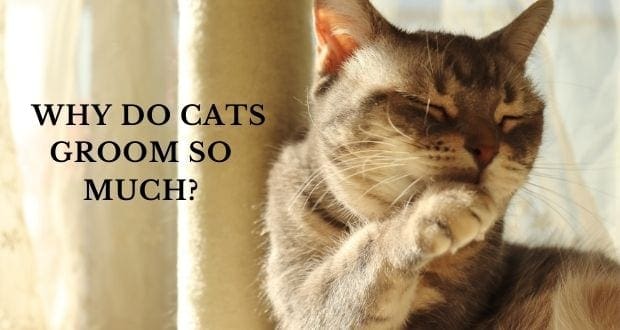
There are so many things to love about cats. One thing humans truly appreciate is that cats are very clean and take meticulous care when it comes to personal hygiene. In fact, grooming takes up a big chunk of a cat’s day. It’s estimated that cats can spend as much as 30-50 percent of their waking hours involved in grooming. All that grooming isn’t done just to look good. The grooming a cat does serves many important functions.
Good Coat Condition
Daily grooming helps the cat remove dander and loose hairs from the coat. As the cat licks, his tongue also spreads the sebum which contributes to giving the coat a beautiful luster.
After eating, the cat engages in a good face washing by licking his paws and using them as furry washcloths. Upon exiting the litter box, the cat will also typically do a little clean-up of the hindquarters.
Even the cat’s nails are maintained through scratching behavior. When the cat digs his claws into the scratching post, he’s conditioning the claws by removing the outer dead nail sheath to reveal the healthy new growth beneath (cats need to scratch for a variety of reasons as well, not just for claw conditioning).
Parasite Control
Grooming helps the cat remove fleas, ticks and other external parasites. One of the reasons you may not even realize your cat has a flea problem is because of the meticulous grooming. You may never actually see a flea moving around. It often surprises many cat parents when they discover the reason for the cat’s skin irritation or constant itching is due to fleas.
Temperature Control
Cats have a limited ability to sweat through their paw pads. This is why you may notice those damp paw prints on the examination table when your cat is getting his yearly check-up. The most efficient cooling system they have is through evaporation. The cat uses his tongue to wet the fur and then evaporation of the saliva cools him down.
Self Scent Identification
Have you ever noticed how your cat may begin grooming after you’ve petted or brushed him? That’s because the cat wants to re-establish his own scent again. Kitty will also often self groom after returning from the outdoors, the veterinary clinic, or after returning home from any other travel.
Displacement Grooming
This is the most common displacement behavior cats exhibit. It appears to be a valuable coping mechanism for dealing with stress and conflict. It may look odd to see a cat in a tense stand-off suddenly engage in self grooming but it’s most likely how to control anxiety and keep arousal level in check. A cat may also use displacement grooming to deal with frustration, for example: the cat who isn’t let outside when crying at the door may begin to groom.
Although displacement grooming is a normal stress-relieving behavior, too much of it may be an indication your cat is under constant stress. If you notice an increase in the behavior or if the grooming is causing bald spots (the cat may even start pulling out hair), contact your veterinarian. After medical causes are ruled out you may be referred to a qualified behavior professional such as a veterinary behaviorist.
Cats Groom to Create a Group Scent
This becomes critically important in a cat colony. As humans, we largely depend on sight to recognize each other but cats rely heavily on scent recognition. Cats in a colony will groom each other to create an identifiable and comforting group scent.
Social Grooming
Cats who have a friendly relationship often engage in allogrooming. This affectionate display is relaxing and shows trust.
Illness or Pain
A common sign indicating that your cat isn’t feeling well will be a lack of normal grooming. An unkempt coat is often a signal that kitty is either ill or in pain.
Another sign of potential illness or pain is when your cat excessively grooms. He may concentrate on a particular area of the body that’s causing discomfort. For example, a cat with a urinary tract problem may excessively lick his genitals or abdomen. A cat in arthritic pain may excessively groom that particular spot, such as a paw or leg.
Skin irritation or allergies (such as a flea allergy or food allergy) can also cause overgrooming.
Wound Healing
Animals lick wounds as a form of healing and also to relieve pain or itch. Unfortunately, too much licking often leads to irritation or even infection.
Prey and Predator Protection
Cats wear the unique label of being both a prey animal as well as a predator. Grooming plays a critical role in their survival here. After capturing and consuming prey, the cat (in the role as predator) must groom to remove all traces of the prey. This post-meal grooming ritual will help to avoid alerting other prey in the area that a hunter is nearby. Since the cat is also small enough to be a prey animal, post-meal grooming also helps avoid announcing his presence to larger predators who may be lurking.
Circulation
When the cat licks his body, the barbs covering the tongue help stimulate circulation. This is why it’s important to maintain a good brushing schedule with your cat as he ages or becomes ill. Your cat will benefit from the increased circulation provided by the brush.
When Should You be Concerned About Your Cat’s Grooming Behavior?
Too little or too much grooming are both red flags indicating a potential medical or emotional issue. Both behaviors shouldn’t be ignored because the underlying problem could actually be life-threatening (as in the case of over-grooming of genitals due to urinary blockage).
Any change in your cat’s normal grooming routine or any change in other behaviors are cause for a trip to the veterinary clinic.
Not everyone actually sees their cats grooming. Your cat may be a secret excessive groomer. If your cat is fearful and tends to hide often you may not be aware of how much is being done. In that case, pay attention to any thinning hair, broken-off hairs or bald spots.
The Other Side Effect of Over-Grooming
Hairballs. Although cats who engage in a normal amount of grooming may still hack up a hairball now and then, the excessive over-groomer is most at risk of developing hairballs that can lead to intestinal blockage. Talk to your veterinarian if your cat has hairballs. In addition to treating the underlying physical or emotional cause of the over-grooming, your veterinarian may prescribe a hairball prevention protocol.
Need More Information?
For more information on cat behavior and reducing stress in cats, refer to the best-selling books by Pam Johnson-Bennett. Pam’s books are available at bookstores and online. We’ve included links to Amazon here on our website.
If you have a question about your cat’s behavior or health, contact your veterinarian. This article is not intended as a medical diagnosis nor is it a replacement for your cat’s regular veterinary care. This article is for general information purposes only.
 Problem Solving & Advice by Pam Johnson-Bennett Cat Behavior Expert & Best-selling Author
Problem Solving & Advice by Pam Johnson-Bennett Cat Behavior Expert & Best-selling Author




